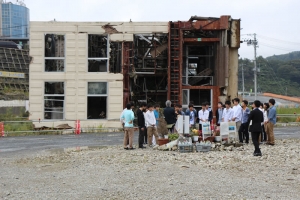Disaster Relief and Community Medicine in Tohoku (Part 3 of 3)
Part 3- Improving Healthcare: Higher Standards of Community Medicine
Nicole Gunawansa | March 27th, 2015
This interview was held on January 14, 2015 in Tohoku University Hospital
Question 9: What are the most important characteristics of the medical dispatching system of rotating physicians at Tohoku University?
In this circulating system, doctors spend four months in a coastal area and eight months working/doing research with the university as a part of the ToMMo Clinical Fellows (TCF) Program. With TCF, these young physicians can participate in the dispatching system without having to forgo the development/specialization of their careers.
There are fourteen clinical departments at this university which coordinate with the dispatching system. Cooperation and collaboration among these departments is the only way to successfully implement this complex system. This system is difficult to implement because of traditional sectionalism; individual departments working separately does not allow for beneficial partnerships. Tohoku University Hospital is taking on the challenge of this integrated system. We are very fortunate that so many departments here are motivated to work together to assist the local and regional medical systems.

Dr. Ishii has been conducting the field work study programs for junior medical students in affected area since 2013.
Question 10: What method does Tohoku University employ to encourage regional medicine in the Tohoku area?
Primary factors necessary to facilitate community based medicine are funding and motivated physicians. Our aim in training physicians is to teach them how to appropriately and tactfully handle local and regional healthcare issues. To promote this concept, our lecturers are teaching the students so that they can one day become well-rounded medical professionals.
Question 11: How far has Japan come since 3/11? Additionally, how have you or your work changed from the time of the disaster?
The Japanese people, after 3/11, have noticed that natural disasters are a serious problem. They now realize that appropriate planning and collaboration is needed to promote the safety of Japan and its people.
Before the disaster, I was just a surgeon. Now I work as a professor at Tohoku University School of Medicine, educating others about regional healthcare systems, coordinating the ToMMo Clinical Fellows Program, managing the ACT organization, etc. In a sense, I have become more of a bureaucrat and less of a doctor. Nevertheless, this unpredicted career transition has been welcomed because I am an alumnus of Tohoku University, and I love this university, and I am proud to help this institution move Japan forward.
| Comments from the Interviewer Having finally had the opportunity to visit Ishinomaki City, I can better appreciate Dr. Ishii’s account of his experiences during the disaster. Even four years later, the coastline of Ishinomaki is barren and unpopulated due to the havoc caused by 3/11. Visiting was a sobering experience, which helped me comprehend the vast amount of recovery the people of Tohoku are dealing with. Nevertheless, my conversation with Dr. Ishii reminded me of the effective and hopeful disaster relief work happening in this region. His commentary about the disaster aftermath shed light onto the importance of disaster preparedness. He described how appropriately trained staff can help make a devastating situation less distressing simply by knowing emergency protocol and having the capacity for innovative thinking. I greatly enjoyed discussing the fact that the key to successful relief efforts lies in the cultivation of human resources. I firmly agree with Dr. Ishii’s sentiments, and believe that this information presents a helpful way of approaching disaster medicine policy reform domestically and abroad. Dr. Ishii and his teams (including ACT) are working hard to share their disaster knowledge, but he also addresses that interdepartmental and administration cooperation is sometimes difficult to implement. While I understand that this is true, I also believe that hospitals not employing this beneficial system are limiting themselves and depriving their communities of a valuable safety net. Increase partnership provides a method to improve standardization of relief protocol. I am not certain of the future of disaster relief policy, but, like Dr. Ishii, I hope to see these positive changes occurring for the advancement of disaster medicine. |
